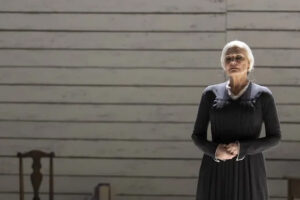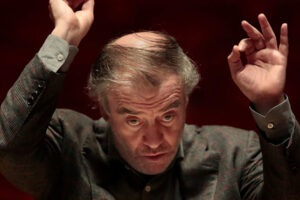

Gotham Chamber Opera triumphed a few years ago with La Bella Dormente in Bosco. But Respighi’s gift was for a sort of visual-aural impressionism, turning his world into orchestral effects; therefore words, with their precision of meaning, got in his way.
La Campana Sommersa (The Sunken Bell), which is being presented by the New York City Opera at the Rose Theater through April 7, is a true oddball, a concatenation of fairy tales from 1927 (it played the Met in ’29), based on an 1896 poetic drama by the “Volkish” (later Nazi) German playwright Gerhardt Hauptmann. The libretto, to put it politely, lacks clarity, cluttered with too many fairy tale elements, such as Fire, Water, Metallurgy, Church and Society. The message is muffled, unfathomable one might say.
NYCO is giving the piece with a production devised for the opera house of Cagliari, Sardinia, and if you are going to produce La Campana Sommersa, this is certainly the way to do it. The orchestra makes the most of Respighi’s fascinating tinkles and touches, the singers are mighty impressive, the sets (deep woods, a full moon ritual, a Gothic apartment, a forge on a cliff’s edge complete with turbulent waterfall) are created by state-of-the-art projections that make the narrow stage of the Rose Theater at Columbus Circle a thing enormous and richly devised. The opera pleased us and held us without quite clarifying its own objectives as story.
No one (even my pocket German dictionary) is much help explaining the meaning of “Rautendelein,” and the libretto is not clear on what exactly she may be: a wood spirit, a foundling raised by magical beings? She is played, in a star-making performance, by Brandie Sutton, a pretty woman of dignified presence with a tireless silvery soprano, the sort that Richard Strauss loved to exploit (a sure-fire Daphne, I’d say).
She has deep womanly power to support her ascent of lofty, circuitous lines or else Respighi wrote very cleverly indeed, without straining the voice as Strauss often did. Perhaps the answer is both.
The story begins a bit like Russalka: the girl is some sort of forest spirit of uncertain parentage, her hand and other body parts sought by a scaly lizard gnome named Ondino (baritone Michael Chioldi, a smooth, even tone with an aura of menace) and a buff, green-skinned, horn-headed Faun (tenor Glenn Seven Allen, a vigorous, hoof-stomping essay), though she is under the advisement of her “grandmother,” the Witch, Renata Lamanda, who is impressively earthmothery but doesn’t have as much fun as Russalka’s Jezibaba does.
As in Russalka, Rautendelein becomes fascinated by a human who cannot see her. This is Enrico, portrayed on opening night by tenor Marc Heller. The part has been double-cast for its length and required brilliance on top, and Heller had everything: power, line, legato and forceful or romantic or pitiable acting as the occasion required.
Enrico is a metalsmith who has created a monumental church bell, so offending the mischievous Faun (who resents intrusive human civilization and its product, Christianity) that he has toppled the bell into the depths of a lake (depicted on video), giving us our title and perhaps a key metaphor for something or other.
The disaster has both upset and injured Enrico, who has run off to the woods to collapse. Rautendelein surrounds him with a magical circle and cures him. (Warning: Wiccans may find this scene triggering; she casts the circle Widdershins.) During a ritual of the forest nymphs to the Full Moon (more video, plus druids with light-up eyes), she resolves to follow Enrico to the human world.
There (in Act II), she soon cures and seduces Enrico, though he gets a fine duet with his wife, the deep and moving mezzo of Kristin Sampson. Having left his family and faith, he resolves (in Act III) to erect a Temple to the Norse god Balder. A furious debate with the local priest (Philip Cokorinos, holding forth indomitably), gets them nowhere, but the news of his wife’s suicide and the ringing of the drowned bell drive Enrico to renounce Rautendelein and his new religion.
In Act IV, as in the final scene of Russalka, Enrico repents everything he’s ever done, sees Rautendelein one last time (she has married, on the rebound, Ondino, the green lizard troll) and dies in her arms. It is a major difference between this opera and Dvorak’s that Respighi and his source are just as interested in the humans as they are in the magical creatures, and that we sympathize with both.
The scenic and video designer Juan Guillermo Nova deserves most of the credit for making this elaborate clash of symbolic story elements so fascinating to watch that we hardly question whether any of it makes sense. Susan Noth’s lighting is also magical and Marco Nateri’s costumes, if drawn from several different eras and styles, suit characters of clashing species. Still: the Faun and the Ondino are fun to look at, the “elfe” are chic, whatever they are, and Rautendelein looks airy in azure. Pier Francesco Maestrini has directed with restraint, inclined to let the set do as much of the work as it can.
A melding of orchestras, New York and Cagliari, under Ira Levin, made Respighi’s intricate, experimental sound seem bigger than it was without ever drowning the impressive clarity of the singers. It was, especially for an unfamiliar score on an opening night, a seamlessly well-ordered performance. One hopes the revived NYCO will build on such sure and fascinatingly unfamiliar foundations.
La Campana Sommersa’s genealogy is intriguing. Wagner and the Grimms had made Norse mythology intellectually respectable, and after the triumph of Wagner’s operas, every hotshot young composer was eager to try his hand at resurrecting Teutonic folklore or (if not a Teuton) the local traditional product, whatever it might be.
Fairy tales and mythic cycles were suddenly the hot thing. Of all these works—they include Strauss’s debut, Guntram, and Puccini’s, Le Villi, and Janacek’s, Sarka, not to mention the Irish operatic mythos of Rutland Boughton, Dvorak’s Russalka, Reyer’s Sigurd, Ethel Smythe’s Der Wald, the Russian epics of Rimsky-Korsakov and the entire oeuvre of henpecked Siegfried Wagner—just one piece entered the international operatic repertory and stayed there: Hansel und Gretel.
But a number of playwrights were inspired by this vein, among them Ibsen, Gerhardt Hauptmann and Maurice Maeterlinck. Ibsen’s most obviously mythic drama is Peer Gynt, but he played with many a legend-like theme, such as the creative genius who destroys everyone about him and is destroyed himself by a youthful femme fatale, the subject of his 1892 play, The Master Builder.
Four years after that disturbing play appeared, Hauptmann, who became better known for naturalistic and anti-capitalist dramas like The Weavers, produced his poetic verse drama, The Sunken Bell, in which an ambitious craftsman-genius, Heinrich, is encouraged by a wood-spirit to abandon his family and the Christian ambitions that only frustrated him, to make a new religion of his own handiwork.
Like Ibsen’s Solness, Heinrich is goaded by his peculiar girlfriend into self-destructive madness, but the wiser Ibsen kept his characters human and his spectacular climax credible. Myths resound below the surface, like Hauptmann’s fallen bell. Hauptmann’s tale, and the musically attractive opera Respighi made of it 33 years later, are too whimsical, too unreal to be quite human. We do not draw a clear moral and we do not sense a genuine tragedy.
Photo: Sarah Shatz























Comments